Analysis of Niche Tourism, Social Media's Impact on Marketing
VerifiedAdded on 2023/01/16
|9
|1960
|97
Report
AI Summary
This report examines the concept of niche tourism, differentiating it from mainstream tourism by focusing on specific market segments and interests, such as sports, adventure, and art tourism. It traces the historical development of niche tourism and critically evaluates the role of Destination Management Organizations (DMOs) in marketing these specialized tourism segments, including market research, target market identification, promotion, and product development. The report also analyzes the impact of social media on contemporary tourism marketing and branding strategies, particularly concerning millennial tourists, their preferences, and how they utilize social media for travel products. It highlights the significance of social media in reaching target demographics and providing personalized offers, supported by relevant research and industry examples, illustrating how these strategies influence the growth and development of the tourism industry.

Contemporary
Issues
Issues
Paraphrase This Document
Need a fresh take? Get an instant paraphrase of this document with our AI Paraphraser

Table of Contents
MAIN BODY...................................................................................................................................3
Characteristics and definition of niche tourism, role of DMOs ...........................................3
Impact of social media on sports event marketing and branding strategies..........................5
MAIN BODY...................................................................................................................................3
Characteristics and definition of niche tourism, role of DMOs ...........................................3
Impact of social media on sports event marketing and branding strategies..........................5
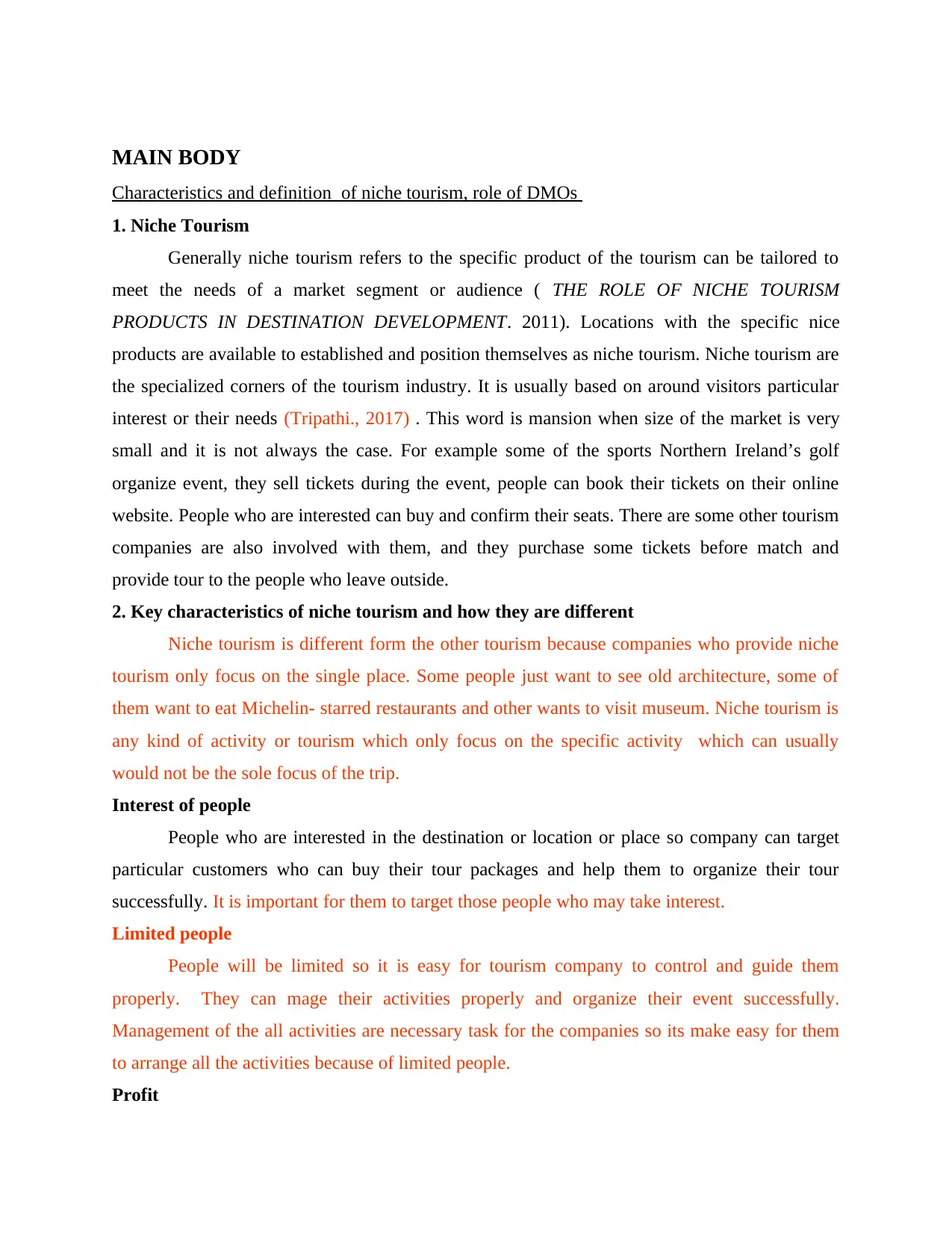
MAIN BODY
Characteristics and definition of niche tourism, role of DMOs
1. Niche Tourism
Generally niche tourism refers to the specific product of the tourism can be tailored to
meet the needs of a market segment or audience ( THE ROLE OF NICHE TOURISM
PRODUCTS IN DESTINATION DEVELOPMENT. 2011). Locations with the specific nice
products are available to established and position themselves as niche tourism. Niche tourism are
the specialized corners of the tourism industry. It is usually based on around visitors particular
interest or their needs (Tripathi., 2017) . This word is mansion when size of the market is very
small and it is not always the case. For example some of the sports Northern Ireland’s golf
organize event, they sell tickets during the event, people can book their tickets on their online
website. People who are interested can buy and confirm their seats. There are some other tourism
companies are also involved with them, and they purchase some tickets before match and
provide tour to the people who leave outside.
2. Key characteristics of niche tourism and how they are different
Niche tourism is different form the other tourism because companies who provide niche
tourism only focus on the single place. Some people just want to see old architecture, some of
them want to eat Michelin- starred restaurants and other wants to visit museum. Niche tourism is
any kind of activity or tourism which only focus on the specific activity which can usually
would not be the sole focus of the trip.
Interest of people
People who are interested in the destination or location or place so company can target
particular customers who can buy their tour packages and help them to organize their tour
successfully. It is important for them to target those people who may take interest.
Limited people
People will be limited so it is easy for tourism company to control and guide them
properly. They can mage their activities properly and organize their event successfully.
Management of the all activities are necessary task for the companies so its make easy for them
to arrange all the activities because of limited people.
Profit
Characteristics and definition of niche tourism, role of DMOs
1. Niche Tourism
Generally niche tourism refers to the specific product of the tourism can be tailored to
meet the needs of a market segment or audience ( THE ROLE OF NICHE TOURISM
PRODUCTS IN DESTINATION DEVELOPMENT. 2011). Locations with the specific nice
products are available to established and position themselves as niche tourism. Niche tourism are
the specialized corners of the tourism industry. It is usually based on around visitors particular
interest or their needs (Tripathi., 2017) . This word is mansion when size of the market is very
small and it is not always the case. For example some of the sports Northern Ireland’s golf
organize event, they sell tickets during the event, people can book their tickets on their online
website. People who are interested can buy and confirm their seats. There are some other tourism
companies are also involved with them, and they purchase some tickets before match and
provide tour to the people who leave outside.
2. Key characteristics of niche tourism and how they are different
Niche tourism is different form the other tourism because companies who provide niche
tourism only focus on the single place. Some people just want to see old architecture, some of
them want to eat Michelin- starred restaurants and other wants to visit museum. Niche tourism is
any kind of activity or tourism which only focus on the specific activity which can usually
would not be the sole focus of the trip.
Interest of people
People who are interested in the destination or location or place so company can target
particular customers who can buy their tour packages and help them to organize their tour
successfully. It is important for them to target those people who may take interest.
Limited people
People will be limited so it is easy for tourism company to control and guide them
properly. They can mage their activities properly and organize their event successfully.
Management of the all activities are necessary task for the companies so its make easy for them
to arrange all the activities because of limited people.
Profit
⊘ This is a preview!⊘
Do you want full access?
Subscribe today to unlock all pages.

Trusted by 1+ million students worldwide
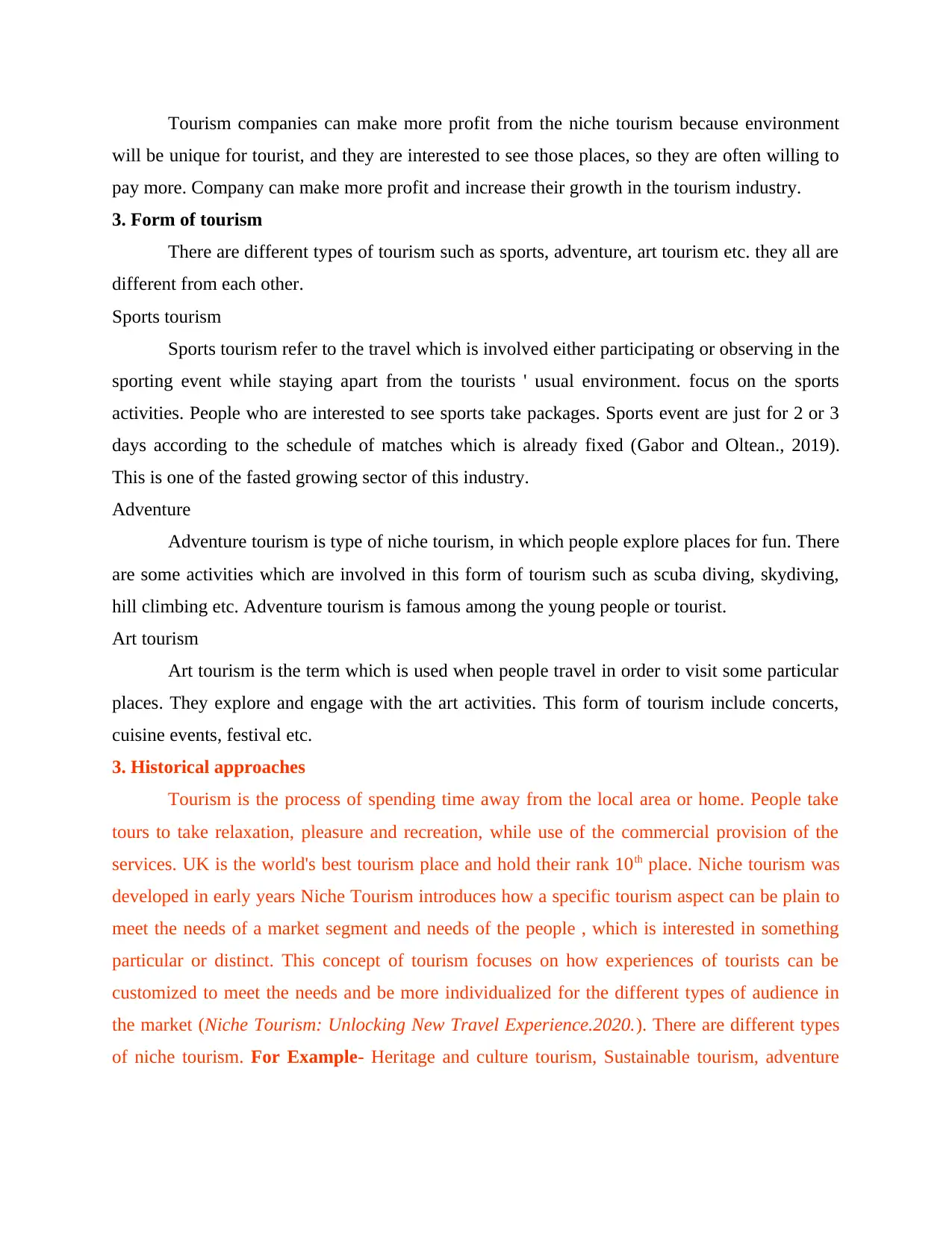
Tourism companies can make more profit from the niche tourism because environment
will be unique for tourist, and they are interested to see those places, so they are often willing to
pay more. Company can make more profit and increase their growth in the tourism industry.
3. Form of tourism
There are different types of tourism such as sports, adventure, art tourism etc. they all are
different from each other.
Sports tourism
Sports tourism refer to the travel which is involved either participating or observing in the
sporting event while staying apart from the tourists ' usual environment. focus on the sports
activities. People who are interested to see sports take packages. Sports event are just for 2 or 3
days according to the schedule of matches which is already fixed (Gabor and Oltean., 2019).
This is one of the fasted growing sector of this industry.
Adventure
Adventure tourism is type of niche tourism, in which people explore places for fun. There
are some activities which are involved in this form of tourism such as scuba diving, skydiving,
hill climbing etc. Adventure tourism is famous among the young people or tourist.
Art tourism
Art tourism is the term which is used when people travel in order to visit some particular
places. They explore and engage with the art activities. This form of tourism include concerts,
cuisine events, festival etc.
3. Historical approaches
Tourism is the process of spending time away from the local area or home. People take
tours to take relaxation, pleasure and recreation, while use of the commercial provision of the
services. UK is the world's best tourism place and hold their rank 10th place. Niche tourism was
developed in early years Niche Tourism introduces how a specific tourism aspect can be plain to
meet the needs of a market segment and needs of the people , which is interested in something
particular or distinct. This concept of tourism focuses on how experiences of tourists can be
customized to meet the needs and be more individualized for the different types of audience in
the market (Niche Tourism: Unlocking New Travel Experience.2020.). There are different types
of niche tourism. For Example- Heritage and culture tourism, Sustainable tourism, adventure
will be unique for tourist, and they are interested to see those places, so they are often willing to
pay more. Company can make more profit and increase their growth in the tourism industry.
3. Form of tourism
There are different types of tourism such as sports, adventure, art tourism etc. they all are
different from each other.
Sports tourism
Sports tourism refer to the travel which is involved either participating or observing in the
sporting event while staying apart from the tourists ' usual environment. focus on the sports
activities. People who are interested to see sports take packages. Sports event are just for 2 or 3
days according to the schedule of matches which is already fixed (Gabor and Oltean., 2019).
This is one of the fasted growing sector of this industry.
Adventure
Adventure tourism is type of niche tourism, in which people explore places for fun. There
are some activities which are involved in this form of tourism such as scuba diving, skydiving,
hill climbing etc. Adventure tourism is famous among the young people or tourist.
Art tourism
Art tourism is the term which is used when people travel in order to visit some particular
places. They explore and engage with the art activities. This form of tourism include concerts,
cuisine events, festival etc.
3. Historical approaches
Tourism is the process of spending time away from the local area or home. People take
tours to take relaxation, pleasure and recreation, while use of the commercial provision of the
services. UK is the world's best tourism place and hold their rank 10th place. Niche tourism was
developed in early years Niche Tourism introduces how a specific tourism aspect can be plain to
meet the needs of a market segment and needs of the people , which is interested in something
particular or distinct. This concept of tourism focuses on how experiences of tourists can be
customized to meet the needs and be more individualized for the different types of audience in
the market (Niche Tourism: Unlocking New Travel Experience.2020.). There are different types
of niche tourism. For Example- Heritage and culture tourism, Sustainable tourism, adventure
Paraphrase This Document
Need a fresh take? Get an instant paraphrase of this document with our AI Paraphraser
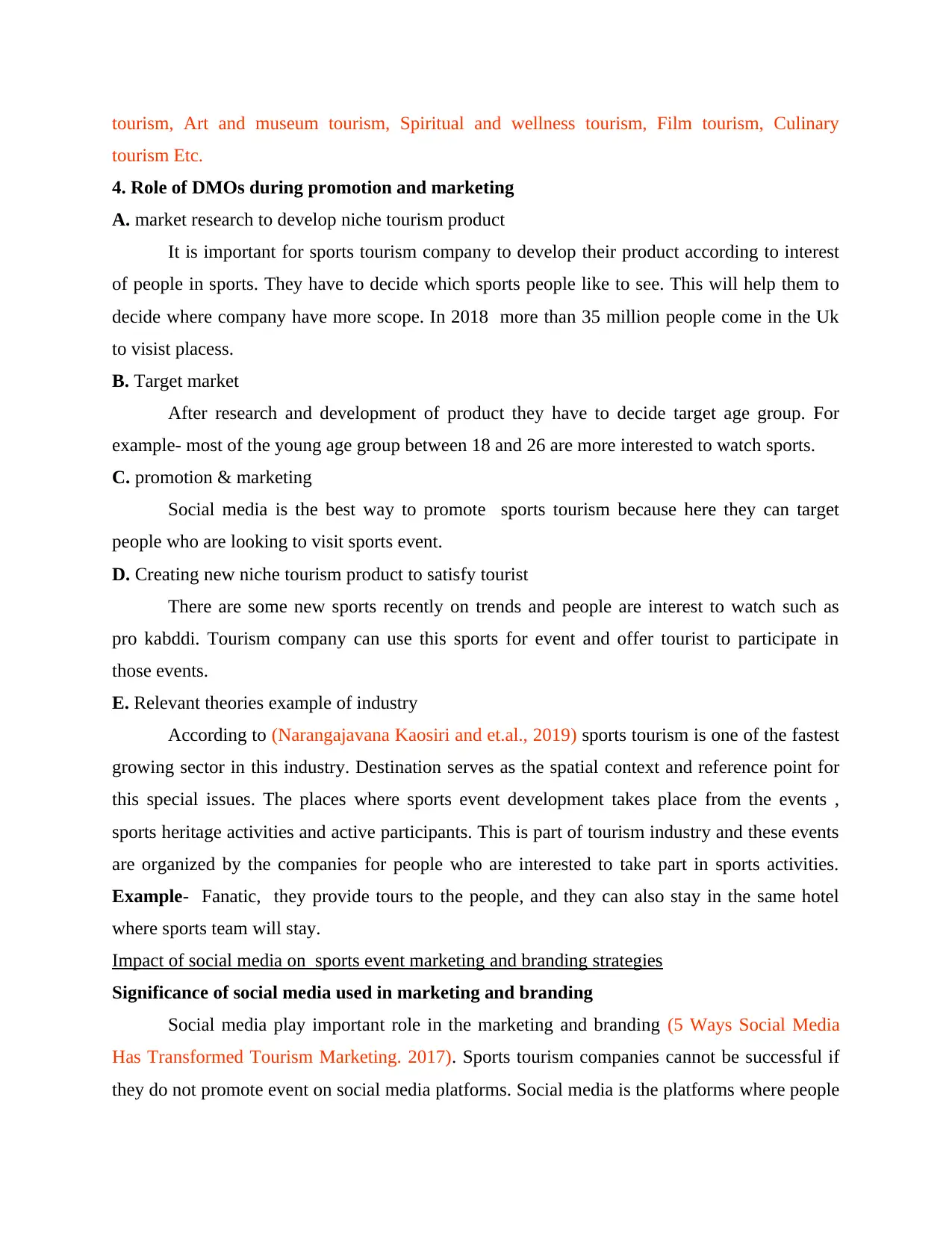
tourism, Art and museum tourism, Spiritual and wellness tourism, Film tourism, Culinary
tourism Etc.
4. Role of DMOs during promotion and marketing
A. market research to develop niche tourism product
It is important for sports tourism company to develop their product according to interest
of people in sports. They have to decide which sports people like to see. This will help them to
decide where company have more scope. In 2018 more than 35 million people come in the Uk
to visist placess.
B. Target market
After research and development of product they have to decide target age group. For
example- most of the young age group between 18 and 26 are more interested to watch sports.
C. promotion & marketing
Social media is the best way to promote sports tourism because here they can target
people who are looking to visit sports event.
D. Creating new niche tourism product to satisfy tourist
There are some new sports recently on trends and people are interest to watch such as
pro kabddi. Tourism company can use this sports for event and offer tourist to participate in
those events.
E. Relevant theories example of industry
According to (Narangajavana Kaosiri and et.al., 2019) sports tourism is one of the fastest
growing sector in this industry. Destination serves as the spatial context and reference point for
this special issues. The places where sports event development takes place from the events ,
sports heritage activities and active participants. This is part of tourism industry and these events
are organized by the companies for people who are interested to take part in sports activities.
Example- Fanatic, they provide tours to the people, and they can also stay in the same hotel
where sports team will stay.
Impact of social media on sports event marketing and branding strategies
Significance of social media used in marketing and branding
Social media play important role in the marketing and branding (5 Ways Social Media
Has Transformed Tourism Marketing. 2017). Sports tourism companies cannot be successful if
they do not promote event on social media platforms. Social media is the platforms where people
tourism Etc.
4. Role of DMOs during promotion and marketing
A. market research to develop niche tourism product
It is important for sports tourism company to develop their product according to interest
of people in sports. They have to decide which sports people like to see. This will help them to
decide where company have more scope. In 2018 more than 35 million people come in the Uk
to visist placess.
B. Target market
After research and development of product they have to decide target age group. For
example- most of the young age group between 18 and 26 are more interested to watch sports.
C. promotion & marketing
Social media is the best way to promote sports tourism because here they can target
people who are looking to visit sports event.
D. Creating new niche tourism product to satisfy tourist
There are some new sports recently on trends and people are interest to watch such as
pro kabddi. Tourism company can use this sports for event and offer tourist to participate in
those events.
E. Relevant theories example of industry
According to (Narangajavana Kaosiri and et.al., 2019) sports tourism is one of the fastest
growing sector in this industry. Destination serves as the spatial context and reference point for
this special issues. The places where sports event development takes place from the events ,
sports heritage activities and active participants. This is part of tourism industry and these events
are organized by the companies for people who are interested to take part in sports activities.
Example- Fanatic, they provide tours to the people, and they can also stay in the same hotel
where sports team will stay.
Impact of social media on sports event marketing and branding strategies
Significance of social media used in marketing and branding
Social media play important role in the marketing and branding (5 Ways Social Media
Has Transformed Tourism Marketing. 2017). Sports tourism companies cannot be successful if
they do not promote event on social media platforms. Social media is the platforms where people
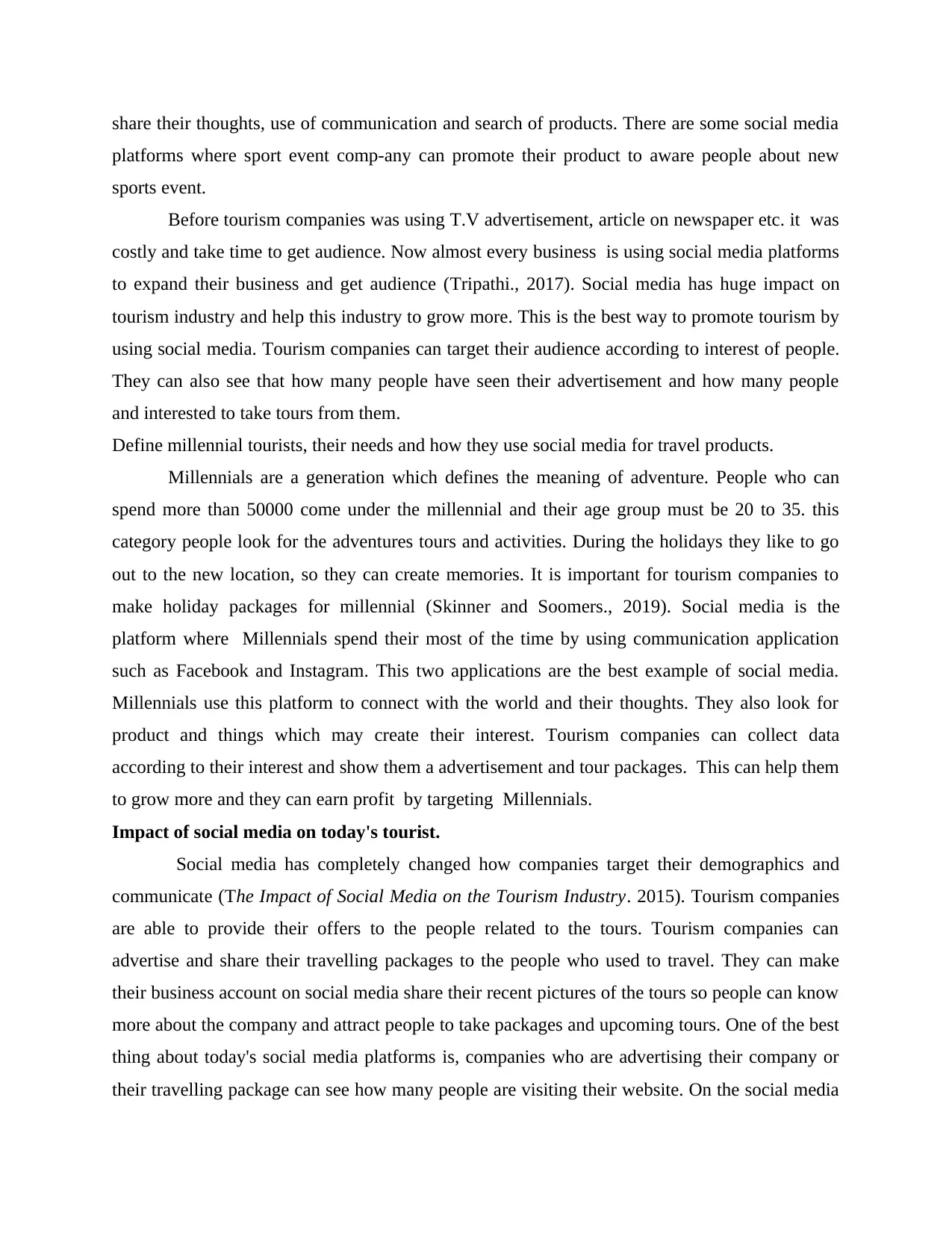
share their thoughts, use of communication and search of products. There are some social media
platforms where sport event comp-any can promote their product to aware people about new
sports event.
Before tourism companies was using T.V advertisement, article on newspaper etc. it was
costly and take time to get audience. Now almost every business is using social media platforms
to expand their business and get audience (Tripathi., 2017). Social media has huge impact on
tourism industry and help this industry to grow more. This is the best way to promote tourism by
using social media. Tourism companies can target their audience according to interest of people.
They can also see that how many people have seen their advertisement and how many people
and interested to take tours from them.
Define millennial tourists, their needs and how they use social media for travel products.
Millennials are a generation which defines the meaning of adventure. People who can
spend more than 50000 come under the millennial and their age group must be 20 to 35. this
category people look for the adventures tours and activities. During the holidays they like to go
out to the new location, so they can create memories. It is important for tourism companies to
make holiday packages for millennial (Skinner and Soomers., 2019). Social media is the
platform where Millennials spend their most of the time by using communication application
such as Facebook and Instagram. This two applications are the best example of social media.
Millennials use this platform to connect with the world and their thoughts. They also look for
product and things which may create their interest. Tourism companies can collect data
according to their interest and show them a advertisement and tour packages. This can help them
to grow more and they can earn profit by targeting Millennials.
Impact of social media on today's tourist.
Social media has completely changed how companies target their demographics and
communicate (The Impact of Social Media on the Tourism Industry. 2015). Tourism companies
are able to provide their offers to the people related to the tours. Tourism companies can
advertise and share their travelling packages to the people who used to travel. They can make
their business account on social media share their recent pictures of the tours so people can know
more about the company and attract people to take packages and upcoming tours. One of the best
thing about today's social media platforms is, companies who are advertising their company or
their travelling package can see how many people are visiting their website. On the social media
platforms where sport event comp-any can promote their product to aware people about new
sports event.
Before tourism companies was using T.V advertisement, article on newspaper etc. it was
costly and take time to get audience. Now almost every business is using social media platforms
to expand their business and get audience (Tripathi., 2017). Social media has huge impact on
tourism industry and help this industry to grow more. This is the best way to promote tourism by
using social media. Tourism companies can target their audience according to interest of people.
They can also see that how many people have seen their advertisement and how many people
and interested to take tours from them.
Define millennial tourists, their needs and how they use social media for travel products.
Millennials are a generation which defines the meaning of adventure. People who can
spend more than 50000 come under the millennial and their age group must be 20 to 35. this
category people look for the adventures tours and activities. During the holidays they like to go
out to the new location, so they can create memories. It is important for tourism companies to
make holiday packages for millennial (Skinner and Soomers., 2019). Social media is the
platform where Millennials spend their most of the time by using communication application
such as Facebook and Instagram. This two applications are the best example of social media.
Millennials use this platform to connect with the world and their thoughts. They also look for
product and things which may create their interest. Tourism companies can collect data
according to their interest and show them a advertisement and tour packages. This can help them
to grow more and they can earn profit by targeting Millennials.
Impact of social media on today's tourist.
Social media has completely changed how companies target their demographics and
communicate (The Impact of Social Media on the Tourism Industry. 2015). Tourism companies
are able to provide their offers to the people related to the tours. Tourism companies can
advertise and share their travelling packages to the people who used to travel. They can make
their business account on social media share their recent pictures of the tours so people can know
more about the company and attract people to take packages and upcoming tours. One of the best
thing about today's social media platforms is, companies who are advertising their company or
their travelling package can see how many people are visiting their website. On the social media
⊘ This is a preview!⊘
Do you want full access?
Subscribe today to unlock all pages.

Trusted by 1+ million students worldwide

profile companies can also take feedback from people who have taken tour from company and
share their experience so people can show more interest on their company.
share their experience so people can show more interest on their company.
Paraphrase This Document
Need a fresh take? Get an instant paraphrase of this document with our AI Paraphraser
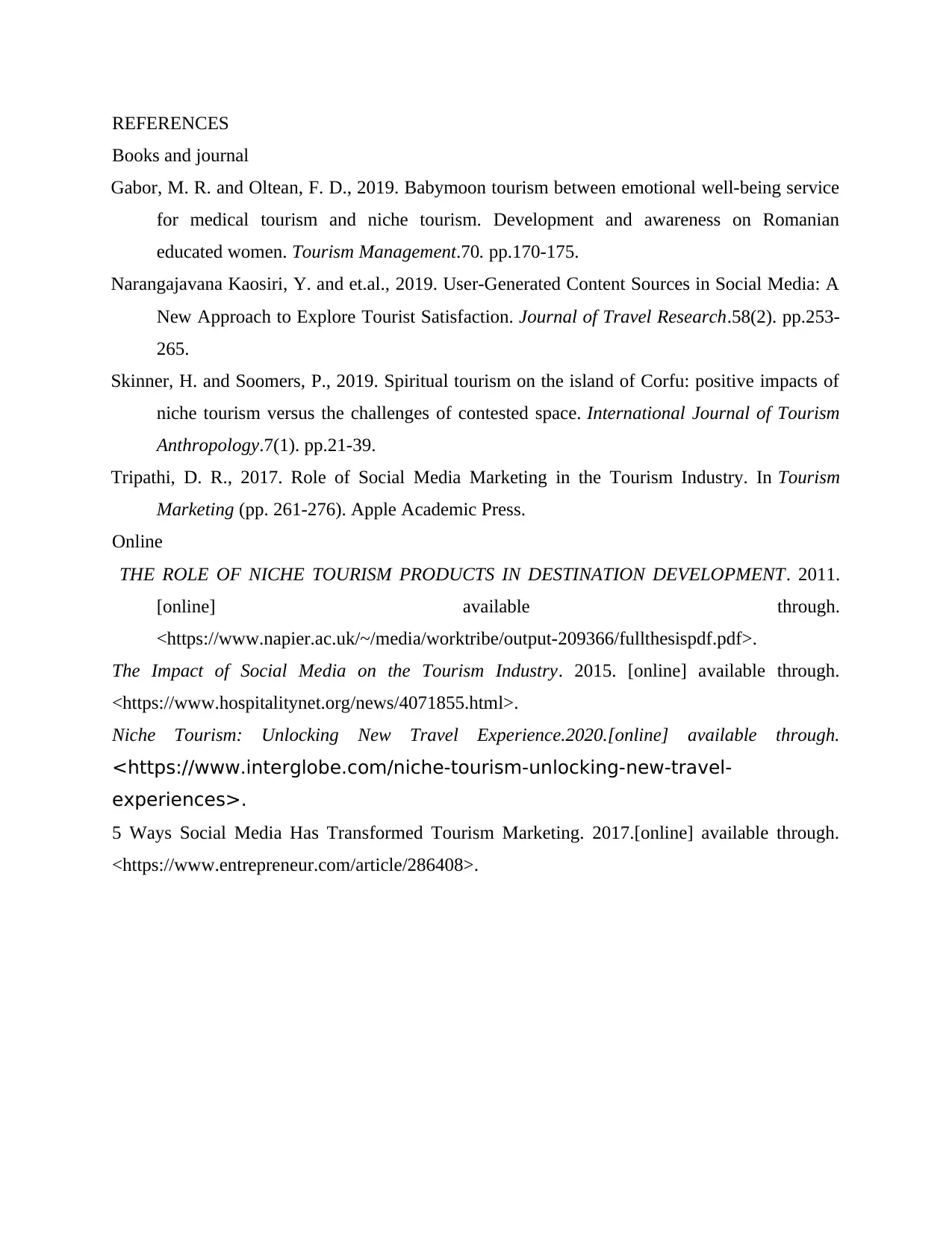
REFERENCES
Books and journal
Gabor, M. R. and Oltean, F. D., 2019. Babymoon tourism between emotional well-being service
for medical tourism and niche tourism. Development and awareness on Romanian
educated women. Tourism Management.70. pp.170-175.
Narangajavana Kaosiri, Y. and et.al., 2019. User-Generated Content Sources in Social Media: A
New Approach to Explore Tourist Satisfaction. Journal of Travel Research.58(2). pp.253-
265.
Skinner, H. and Soomers, P., 2019. Spiritual tourism on the island of Corfu: positive impacts of
niche tourism versus the challenges of contested space. International Journal of Tourism
Anthropology.7(1). pp.21-39.
Tripathi, D. R., 2017. Role of Social Media Marketing in the Tourism Industry. In Tourism
Marketing (pp. 261-276). Apple Academic Press.
Online
THE ROLE OF NICHE TOURISM PRODUCTS IN DESTINATION DEVELOPMENT. 2011.
[online] available through.
<https://www.napier.ac.uk/~/media/worktribe/output-209366/fullthesispdf.pdf>.
The Impact of Social Media on the Tourism Industry. 2015. [online] available through.
<https://www.hospitalitynet.org/news/4071855.html>.
Niche Tourism: Unlocking New Travel Experience.2020.[online] available through.
<https://www.interglobe.com/niche-tourism-unlocking-new-travel-
experiences>.
5 Ways Social Media Has Transformed Tourism Marketing. 2017.[online] available through.
<https://www.entrepreneur.com/article/286408>.
Books and journal
Gabor, M. R. and Oltean, F. D., 2019. Babymoon tourism between emotional well-being service
for medical tourism and niche tourism. Development and awareness on Romanian
educated women. Tourism Management.70. pp.170-175.
Narangajavana Kaosiri, Y. and et.al., 2019. User-Generated Content Sources in Social Media: A
New Approach to Explore Tourist Satisfaction. Journal of Travel Research.58(2). pp.253-
265.
Skinner, H. and Soomers, P., 2019. Spiritual tourism on the island of Corfu: positive impacts of
niche tourism versus the challenges of contested space. International Journal of Tourism
Anthropology.7(1). pp.21-39.
Tripathi, D. R., 2017. Role of Social Media Marketing in the Tourism Industry. In Tourism
Marketing (pp. 261-276). Apple Academic Press.
Online
THE ROLE OF NICHE TOURISM PRODUCTS IN DESTINATION DEVELOPMENT. 2011.
[online] available through.
<https://www.napier.ac.uk/~/media/worktribe/output-209366/fullthesispdf.pdf>.
The Impact of Social Media on the Tourism Industry. 2015. [online] available through.
<https://www.hospitalitynet.org/news/4071855.html>.
Niche Tourism: Unlocking New Travel Experience.2020.[online] available through.
<https://www.interglobe.com/niche-tourism-unlocking-new-travel-
experiences>.
5 Ways Social Media Has Transformed Tourism Marketing. 2017.[online] available through.
<https://www.entrepreneur.com/article/286408>.

1
⊘ This is a preview!⊘
Do you want full access?
Subscribe today to unlock all pages.

Trusted by 1+ million students worldwide
1 out of 9
Related Documents
Your All-in-One AI-Powered Toolkit for Academic Success.
+13062052269
info@desklib.com
Available 24*7 on WhatsApp / Email
![[object Object]](/_next/static/media/star-bottom.7253800d.svg)
Unlock your academic potential
Copyright © 2020–2025 A2Z Services. All Rights Reserved. Developed and managed by ZUCOL.





